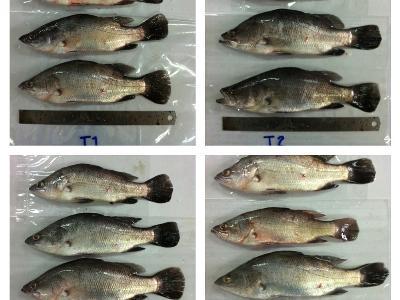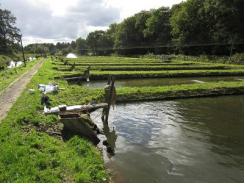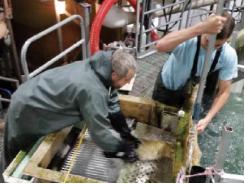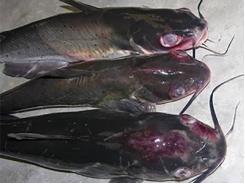Improving productivity, efficiency in Asian sea bass aquaculture

Study shows dietary additive potassium diformate improves growth and survival
Sea bass in the control group reached a mean final body weight of 54.5±7.5 g, while the fish fed with potassium diformate reached an average weight of 62.7±2.8 g.
Aquaculture production has increased rapidly over the last 30 years, and the amount of edible fisheries products from aquaculture has meanwhile equaled that of capture fisheries. The vast majority of this production occurs in Asia. Farmers in Southeast Asia in particular are keen to find opportunities to economize their production. However, high stocking densities and sub-optimal water quality may impair fish health and growth performance. In the past, antibiotic growth promoters (AGPs) were often used to help overcome these limitations. The routine use of AGPs is a subject for much debate in the animal farming and the feed and food industries. Public opinion and regulatory authorities in most exporting countries now focus on the misuse of antibiotics in aquaculture and public attention has also shifted towards production methods. Here, consumers are increasingly turning to fish from sustainably managed sites. Therefore, alternatives to AGP are sought worldwide in a variety of forms.
Feed additives – acidifiers
Growth and health status in farmed fish may be improved through the application of feed additives to high quality feeds, and this management strategy is one of the main factors supporting current and future success of aquaculture in Southeast Asia and elsewhere. Among these additives, acidifiers have been increasingly used in many fish species over the last decade, and they have been successfully tested in salmon, rainbow trout, African catfish, European sea bass, Asian sea bass, milkfish, tilapia and pangasius, as well as shrimp.
In animal nutrition, acidifiers exert their effects on performance via three different ways, as described by Mechthild Freitag in 2007: (i) in the feed; (ii) in the gastro-intestinal tract of the animal; and (iii) in the animal’s metabolism. A wide range of different organic acids and salts have been tested so far. Diformates, in particular, are widely used in both tropical and cold-water aquaculture, because of their high load of active ingredients and because of their stability and handling properties in extruded feeds. One of the species recently tested with these products is the Asian sea bass (Lates calcarifer).
Asian sea bass
The global production of Asian seabass in 2013 in over ten countries in Asia and Australia/Oceania, as well as the USA, reached almost 70,000 MT, as reported by the FAO. The main producers were Taiwan, Malaysia, Thailand, Indonesia and Australia. Most seabass aquaculture is now carried out with formulated diets, although trash fish is still used under some circumstances. In intensive aquaculture production, bacterial diseases are a major cause of economic loss to producers. The seabass is particularly susceptible to a wide variety of Gram-negative bacteria that cause major, serious diseases. Feeding antibiotic-medicated aquafeeds is still common practice in some countries to treat these bacterial infections. In some areas, the prophylactic use of antibiotics in aquaculture production has also been widespread.
Organic acids and their salts are seen as an alternative to using antibiotics as growth promoters, as one of us (CL) reported in 2006. Of these, potassium diformate (KDF) — the most intensely studied organic acid salt in aquaculture to date — is among the various alternatives used for sustainable aquaculture approaches. Dietary KDF has been tested in several aquaculture species from tropical and temperate regions since 2005. These data were used by one of us (CL) to perform a meta-analysis on its growth promoting effect in tilapia.
Study setup
The current investigation aimed to examine the effects of 0.5 percent KDF in commercial sea bass feeds under research conditions in Thailand. A total of 120 juvenile Asian seabass with a mean weight of 16.50±3.97 g were stocked into twelve 240-L, freshwater aquaria in a completely randomized design. Fish were divided into two groups (negative control and KDF treatment) and reared for 75 days at 26-30°C water temperature. The crude protein content of the Australian-formulated diet was 54 percent. The fish in both the control and KDF treatments were given the appropriate feed with a daily ration equivalent to 3-5 percent of their body weight. Feed was dispensed to the fish three times a day. Water parameters and growth performance of fish were monitored regularly. Data were analyzed using the t-test and a confidence level of 95 percent was defined for these analyses.
Results
The diet supplemented with 0.5 percent KDF yielded improved growth data (P<0.05). Sea bass in the control group reached a mean final body weight of 54.5±7.5 g, while the fish fed with potassium diformate reached an average weight of 62.7±2.8 g (Table 1). Additionally, feed conversion ratio and protein efficiency ratio showed improvements (P=0.06). And the survival rate as well as the fish productivity index — calculated on the basis of weight gain, survival rate and feed conversion, thus combining the three most important parameters in any fish production — improved significantly (P<0.05).
Luckstadt, Table 1
| Parameter | CON | 0.5 percent KDF | P-value |
| Initial weight (g) | 15.8±3.2 | 16.2±4.2 | 0.430 |
| Final weight (g) | 54.5±7.5a | 62.7±2.8b | 0.026 |
| Weight gain (g) | 38.8±6.6a | 46.5±3.8b | 0.028 |
| Survival (%) | 82.0±13.3a | 98.3±3.7b | 0.014 |
| FCR | 2.72±0.94 | 1.95±0.30 | 0.061 |
| FPI* | 141.4±79.9a | 243.2±56.3b | 0.026 |
| PER** | 0.75±0.22 | 0.96±0.14 | 0.055 |
Production parameters of Asian seabass (Lates calcarifer) after 75 days of rearing with or without dietary potassium diformate (KDF).
- a, b: Means with a different superscript differ significantly at P<0.05
- *FPI = Fish Productivity Index: Weight gain [g] × Survival [ percent] / (FCR × 10)
- **PER = Protein Efficiency Ratio: Weight gain [g] / Protein intake [g]
Perspectives
The addition of 0.5 percent KDF in the diets of Asian sea bass significantly improved growth and other production parameters. These findings are in line with several other studies testing the effect of diformates in other species like tilapia (Zhigang Zhou and fellow researchers in China in 2009; Malou Cuvin-Aralar and her colleagues at the Southeast Asian Fisheries Development Center, Aquaculture Department in the Philippines in 2010 and 2011). To date, there had been only speculations as to whether the growth promoting impact of potassium diformate that had been seen in tropical fish species like tilapia, pangasius and milkfish could be repeated in Asian sea bass. Our results in the present study show that including KDF in diets for juvenile Asian sea bass can also help improve growth, survival and therefore overall production of this species – making it an interesting option for improved and sustainable Asian sea bass production.
References available from authors.
Dr. Christian Lückstädt
- Technical Director, Feed
- ADDCON GmbH
- Joseph-Schumpeter-Allee 25, D - 53227
- Bonn, Germany
Dr. Kai-Jens Kühlmann
- Aquaculture Nutritionist
- Bangkok, Thailand
Related news
Tools

Phối trộn thức ăn chăn nuôi

Pha dung dịch thủy canh

Định mức cho tôm ăn

Phối trộn phân bón NPK

Xác định tỷ lệ tôm sống

Chuyển đổi đơn vị phân bón

Xác định công suất sục khí

Chuyển đổi đơn vị tôm

Tính diện tích nhà kính

Tính thể tích ao




 The importance of carotenoids in aquafeeds
The importance of carotenoids in aquafeeds  Novel air-based system transfers large salmon during harvest
Novel air-based system transfers large salmon during harvest